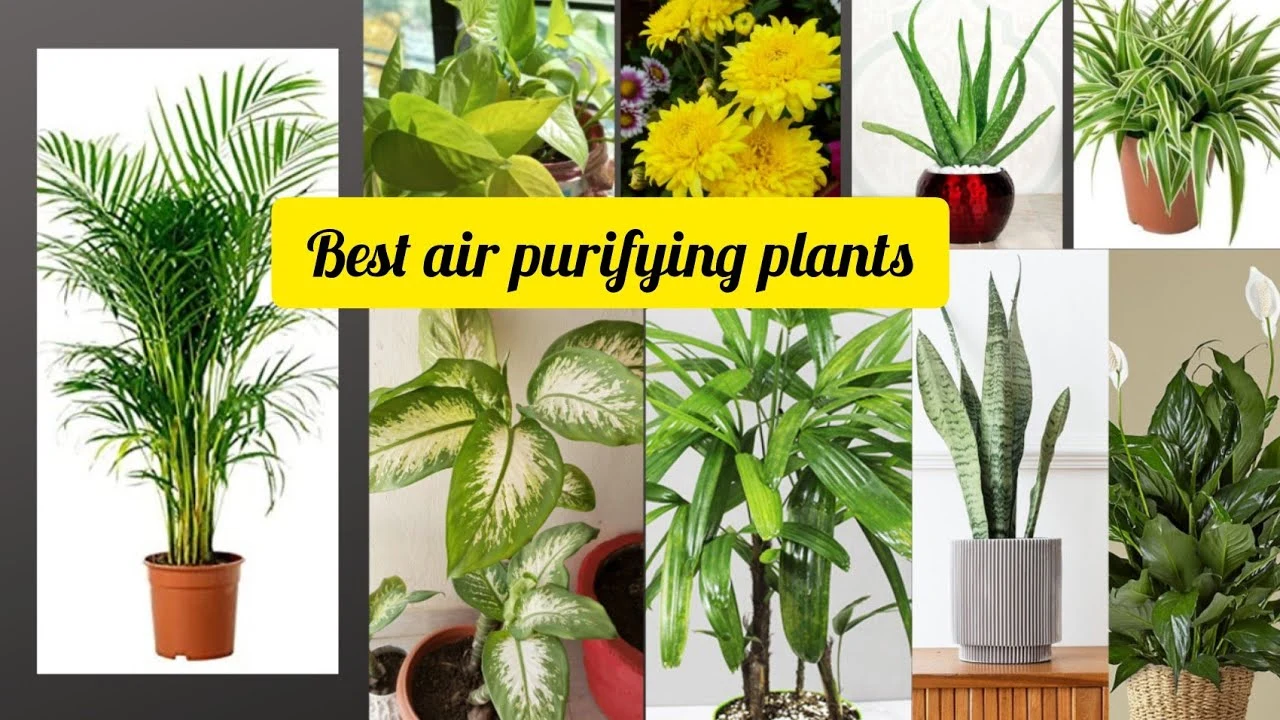The air quality in indoor areas is an increasing concern in the modern office and home. From paint to cleaning products and furniture, hidden pollutants can circulate in the indoor environment and negatively impact our health. Thankfully, nature has a simple solution–air-purifying plants. These plants are not just beautiful but also remove harmful pollutants, ensuring clean air indoors. We’ll look at the advantages of air purifying plants as well as the best ones for homes, as well as useful gardening tips to keep your living spaces clean, healthy,and full of life.
Why Air-Purifying Plants Are Essential
1. Natural Air Filters
Contrary to machines, air purifying plants are able to absorb carbon dioxide as well as release oxygen, while taking out harmful toxins such as formaldehyde, benzene, and Trichloroethylene.
2. Boosting Humidity
The plants release water into the air through transpiration, which can help to reduce dryness in indoor areas. The natural moisture boosts the health of your skin, eases respiratory ailments, and makes the air more comfortable.
3. Stress Relief and Better Mood
Greenery in your surroundings reduces anxiety levels, lowers stress levels, and boosts concentration. Studies have shown that offices and homes that are equipped with plants that purify the air have higher productivity and a better state of mind.
4. Affordable and Sustainable
As opposed to costly air purifiers, keeping plants is more cost-effective. They require sunlight, water, and basic maintenance.
Best Air-Purifying Plants for Homes and Offices
Here’s a list of the most efficient air-purifying plants to enhance indoor air quality
1. Snake Plant (Sansevieria)
- What’s it good for? Extremely tough, it absorbs toxins and releases oxygen in the evening.
- Care: Low watering requirements. It can be adapted to low light.
2. Spider Plant (Chlorophytum comosum)
- What’s it good for? removes carbon monoxide as well as formaldehyde. expands quickly.
- Care: It thrives in indirect light with moderate watering.
3. Peace Lily (Spathiphyllum)
- Why it’s awesome: Eliminates ammonia as well as benzene and adds elegance by using white flowers.
- Care is a shade-loving plant that requires regular watering.
4. Aloe Vera
- Why it’s great: It filters benzene and formaldehyde. It also has the ability to heal the skin.
- Care requires sunlight and a minimum amount of irrigation.
5. Areca Palm (Dypsis lutescens)
- Why it’s great: It acts like a natural humidifier and cleans the air.
- Care is in need of direct, bright sunlight as well as regular irrigation.
6. Bamboo Palm (Chamaedorea seifrizii)
- Why it’s great It is effective in eliminating trichloroethylene and benzene.
- Care: It thrives in shade and in moist.
7. Rubber Plant (Ficus elastica)
- What’s great about it? It effectively absorbs formaldehyde.
- Care requires indirect sunlight as well as moderate watering.
8. Boston Fern (Nephrolepis exaltata)
- Why it’s great: The technology removes xylene from the air and provides greenery to humid areas.
- Care requires the highest humidity and indirect sunlight.

Gardening Ideas for Cleaner Indoor Air
1. Create a Balcony Jungle
Make your balcony an oasis of green. Mix high trees that filter air, such as Areca Pal,m with hanging Spider Plants to make the most of the space.
2. Vertical Garden for Apartments
If you have limited space If you are short of space, consider vertical gardening. Install wall-mounted pots or holders for plants to plant Peace Lilies, Ferns, or Money Plants.
3. Tabletop Plant Decor
Install small air purifying plants such as Aloe Vera, as well as Snake Plant, on study tables or office desks, and coffee tables to ensure that you are always fresh.
4. Bathroom Plant Corner
Plants that love humidity, like Boston Fern or Bamboo, thrive in bathrooms, naturally regenerating the air.
5. Kitchen Herb + Air-Purifier Mix
Mix herbs such as Basil, Mint, and Spider Plants to create fresh cooking ingredients as well as healthier indoor air.
How to Care for Air-Purifying Plants
Even though the majority of air purifying plants are not very maintenance-intensive but they can thrive with the right maintenance:
- Light requires Plants to be placed close to windows that receive indirect sunlight. In rooms with darker lighting, you can utilize grow lights.
- Hydration Schedule: Do not overwater. Check soil moisture prior to applying water.
- Soil and Fertilizer Use a well-drained soil. Use organic fertilizer at least once a month in this growing season.
- Pruning: Cut off dead or dying leaves to promote healthy growth.
- Repotting Switch to bigger pots as roots grow out of their pot.
Air-Purifying Plants for Different Rooms
Living Room
- Areca Palm, Rubber Plant, Monstera – statement plants that have strong purifying qualities.
Bedroom
- Snake Plant, Aloe Vera – improve oxygen levels for better sleep.
Kitchen
- Spider Plant, Mint, and Basil have two benefits of purification as well as fresh herbs.
Bathroom
- Peace Lily, Ferns – thrive in extreme humidity and help reduce the growth of mold.
Office/Study
- ZZ Plant, Bamboo Palm is compact and helps relieve stress.
Common Problems and Solutions
Even the top air-purifying plants may have issues.
- Yellow leaves are caused by excessive watering.
- Drooping Plants: Insufficient frequent or uneven watering.
- Pests: Use neem oil spray to get rid of the aphids or spider mites.
- Low Growth: Fertilize or repot the plant to ensure it is getting enough nutrients.
Conclusion
Integrating air purifying plants in your office or house is a simple and efficient way to have better indoor air quality. They range from low-maintenance options such as Snake Plant and Aloe Vera to more decorative options like Peace Lily and Boston Fern. They provide health, happiness, and beauty to your living space.
Simple gardening tips like balcony designs and vertical gardens,s as well as tabletop décor Anyone can reap the advantages of fresh, non-toxic air in the indoors. Begin small, take care of your plants, and you’ll soon be experiencing the refreshing change of a healthier, greener home.
Learn more about air purifying plants on Wikipedia
Visit our blog at Soil and Sprout for more information on indoor plants.
Table of Contents

Chavan Harikrishna is a dedicated content writer with a strong passion for agriculture and gardening. With a keen eye for detail and a love for nature, he creates insightful and engaging content that educates and inspires readers about sustainable farming practices, plant care, and rural development. Harikrishna combines his writing expertise with hands-on experience in agriculture to deliver well-researched and impactful articles that promote a greener and more sustainable world.
